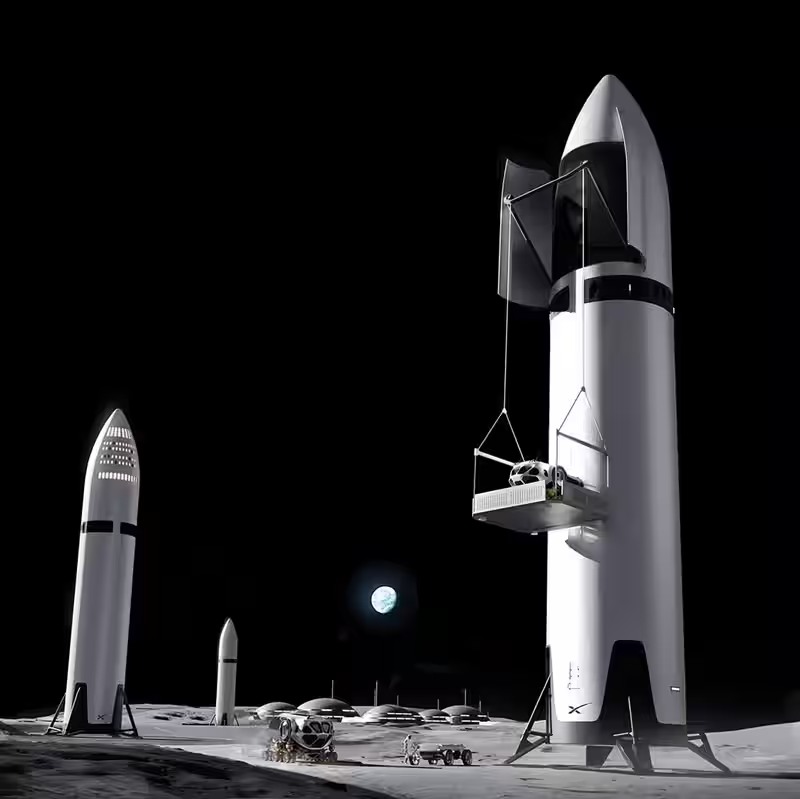Table of Contents
- NASA’s Urgent Call for Faster Moon Landings
- SpaceX Proposes Streamlined Moon Mission
- Blue Origin Offers Simpler, Safer Alternative
- Why Beating China to the Moon Matters
- Musk’s Public Feuds Add Drama to Space Race
- Sources
NASA’s Urgent Call for Faster Moon Landings
In a high-stakes scramble to ensure American astronauts return to the lunar surface before China, NASA has solicited backup moon lander proposals from two of America’s most powerful space companies: SpaceX and Blue Origin.
The request comes amid growing concern that delays in SpaceX’s Starship program—currently under contract for the Artemis III mission—could allow China to plant its flag near the moon’s resource-rich south pole by 2030. With political pressure mounting, NASA wants a viable Plan B ready as early as 2028.
SpaceX Proposes Streamlined Moon Mission
Elon Musk’s SpaceX, which holds a $2.9 billion NASA contract to develop its Starship as the primary Artemis III lander, acknowledged technical hurdles but responded with a revised strategy.
In a detailed update posted October 31, 2025, SpaceX outlined progress on Starship testing and introduced what it calls a “simplified mission architecture” designed to accelerate the timeline while enhancing crew safety. However, critical milestones—like transferring cryogenic propellants between Starships in orbit—remain unproven.
“We’ve shared and are formally assessing a simplified mission architecture… that we believe will result in a faster return to the Moon,” the company stated.
Blue Origin Offers Simpler, Safer Alternative
Meanwhile, Jeff Bezos’ Blue Origin submitted a competing proposal that eliminates the need for complex in-space refueling—a major technical risk in both current NASA plans.
According to insiders familiar with the plan, Blue Origin’s approach combines its larger Blue Moon lander (already contracted for later Artemis missions) with a smaller test vehicle, Blue Moon Mark 1, scheduled to launch next year aboard the New Glenn rocket.
This dual-lander strategy could support an Artemis III landing as early as 2028 without relying on untested orbital fuel transfer technology—potentially offering NASA a lower-risk path back to the moon.
Why Beating China to the Moon Matters
The urgency isn’t just about national pride. The lunar south pole contains water ice in permanently shadowed craters—critical for sustaining long-term human presence and producing rocket fuel.
Former NASA Administrator Bill Nelson put it bluntly: “Possession is nine-tenths of the law.” If China establishes infrastructure first, it could effectively claim strategic territory, limiting U.S. and allied access.
Current acting NASA head Sean Duffy has publicly tied the moon landing goal to the end of President Trump’s potential second term in January 2029, adding political weight to the timeline.
Musk’s Public Feuds Add Drama to Space Race
As competition intensifies, Elon Musk hasn’t shied away from controversy. On X (formerly Twitter), he lashed out at critics, including former NASA chief Jim Bridenstine, calling one official “a 2-digit IQ” appointee.
SpaceX also accused Bridenstine—who now runs a space consulting firm—of lobbying for competitors under the guise of national interest. Bridenstine countered that his firm’s mission is to “ensure the United States remains the pre-eminent space-faring nation.”
Despite the public sparring, experts agree: having multiple credible moon lander options strengthens America’s position in what many now call the “second space race.”
Key Facts at a Glance
| Company | Mission Approach | Target Date | Key Risk |
|---|---|---|---|
| SpaceX | Modified Starship with simplified ops | 2028–2029 | In-orbit propellant transfer unproven |
| Blue Origin | Dual-lander system (Mark 1 + Blue Moon) | 2028 | New Glenn rocket debut pending |
Sources
The New York Times: NASA Gets Moon Lander Plan B’s From SpaceX and Blue Origin




